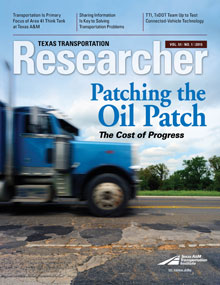The truth is, nobody likes potholes. But when you’re responsible for the integrity of your roadways, finding the funds to proactively plan maintenance is difficult when limited resources are already stretched to the limit. Add to that challenge new energy developments bringing hundreds of heavy trucks to two-lane roads, and it doesn’t take long for those potholes to multiply, sometimes exponentially.

For the past few years, the Texas A&M Transportation Institute (TTI) has studied the relationship between energy developments and the transportation system in Texas. A study in 2011 helped the Texas Department of Transportation and other stakeholders forecast future energy-development locations using a geodatabase and analysis tools prepared by TTI Senior Research Engineer Cesar Quiroga and his team. In 2013, following a study funded by TTI‘s Transportation Policy Research Center, the Institute submitted more detailed findings regarding the impact of the state’s energy-development activities to the Texas Legislative Budget Board.
A new chapter in that research currently being completed by Quiroga correlates locations and trends of oil and gas energy developments with changes in pavement conditions over the last few years. The study is being sponsored by TTI‘s Transportation Policy Research Center and looks at energy developments and roadway infrastructure conditions in three regions — Barnett Shale, Eagle Ford Shale, and Permian Basin — and compares these regions with other parts of the state.
“If we can better understand the relationship between where energy development is happening and the conditions of the transportation network in those areas, state, local and county officials can more effectively plan maintenance activities,” says Quiroga.
Researchers gathered data on pavement conditions — including pavement distress, ride and condition scores at the state, county and regional levels — and overlaid them on an updated county-level geodatabase of energy developments. Some of what they learned is captured in the graphic accompanying this story.
“Our findings reflect the dramatic changes that the energy sector has produced in the state over the last few years, and also looks at the period before that,” says Quiroga. “Compared to 2006–2009, the total number of new horizontal wells developed in 2010–2013 using hydraulic fracturing techniques increased by more than 60 percent statewide. However, changes were much more significant by region — for example, 941 percent in the Eagle Ford Shale region and 240 percent in the Permian Basin region. Hydrocarbon production increased spectacularly as well. Unfortunately, pavement condition scores decreased. Despite increases in maintenance expenditures, it’s clear that the state is not keeping up with these new developments.”

